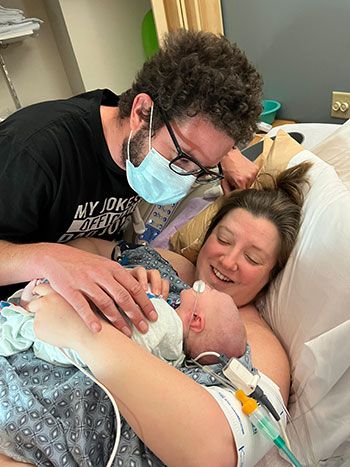Duke Health Performs World’s First Partial Heart Transplant
The procedure allows transplanted heart valves to grow with the patient
 A team at Duke Health has performed what is believed to be the world’s first partial heart transplant, with the living arteries and valves from a freshly donated heart fused onto a patient’s existing heart.
A team at Duke Health has performed what is believed to be the world’s first partial heart transplant, with the living arteries and valves from a freshly donated heart fused onto a patient’s existing heart.
The goal is to allow the valves to grow with the pediatric patient over time, increasing life expectancy. The team believes a similar approach could be used to place newly donated heart valves in countless other children with heart defects.
“This procedure potentially solves the problem of a growing valve,” said Joseph W. Turek, M.D., Ph.D., Duke’s chief of pediatric cardiac surgery, who led the landmark surgery.
“If we can eliminate the need for multiple open-heart surgeries every time a child outgrows an old valve, we could be extending the life of that child by potentially decades or more,” Turek said.
The surgery was performed on 5-pound newborn, Owen Monroe. His family is from Leland, N.C., but he was born at Duke after his parents learned that he had a condition called truncus arteriosus, in which his two main heart arteries were fused together. Worse still, his one vessel was equipped with a leaky valve, making it unlikely he could survive the wait for a full heart transplant.
Typically, children in situations like Owen’s would receive two preserved cadaver arteries with valves. But the implanted tissue used in this procedure doesn’t grow with the child’s own heart because it’s not living. Pediatric patients require multiple follow-up open heart surgeries to replace the valves with larger ones, dramatically limiting their life expectancy.
In the novel partial heart transplant, Turek and the Duke team -- including fellow pediatric heart surgeon, Nicholas Andersen, M.D. and a large team of anesthesiologists, nurses, technicians and support staff -- used living tissue and valves. The tissue was procured from a donor heart that had strong valves, but could not be used for full transplant due to the condition of the muscle.
 The team’s effort to implant valves that could grow along with a patient appears to be a success. Owen is showing remarkable growth and improvements since undergoing the surgery in the spring of 2022, and his outlook remains strong.
The team’s effort to implant valves that could grow along with a patient appears to be a success. Owen is showing remarkable growth and improvements since undergoing the surgery in the spring of 2022, and his outlook remains strong.
“What’s particularly remarkable about this procedure, is that not only is this innovation something that can extend the lives of children, but it makes use of a donated heart that would otherwise not be transplantable,” said Michael Carboni, M.D., an associate professor in the Department of Pediatrics at Duke University School of Medicine and Owen’s pediatric transplant cardiologist.
“The valves in this procedure come from a donor heart that had muscle tissue which was too weak to make it viable for full transplant but had strong valves that were well suited for Owen’s needs.” Carboni said. “This innovation amplifies the ways in which we can use the incredible gift of organ donation to save more lives.”
Experts at Duke are hopeful a similar approach could be used to treat common valve replacements in children, providing a one-time surgery to implant freshly donated tissue that could grow with the child.
“As harrowing of an experience as it was for our family, we knew from the beginning that Owen was in the best hands,” said Nick Monroe, Owen’s father. “Our greatest hope is that Owen’s success story will change the way organ donation and transplants are handled not only for congenital heart disease babies, but for all patients.